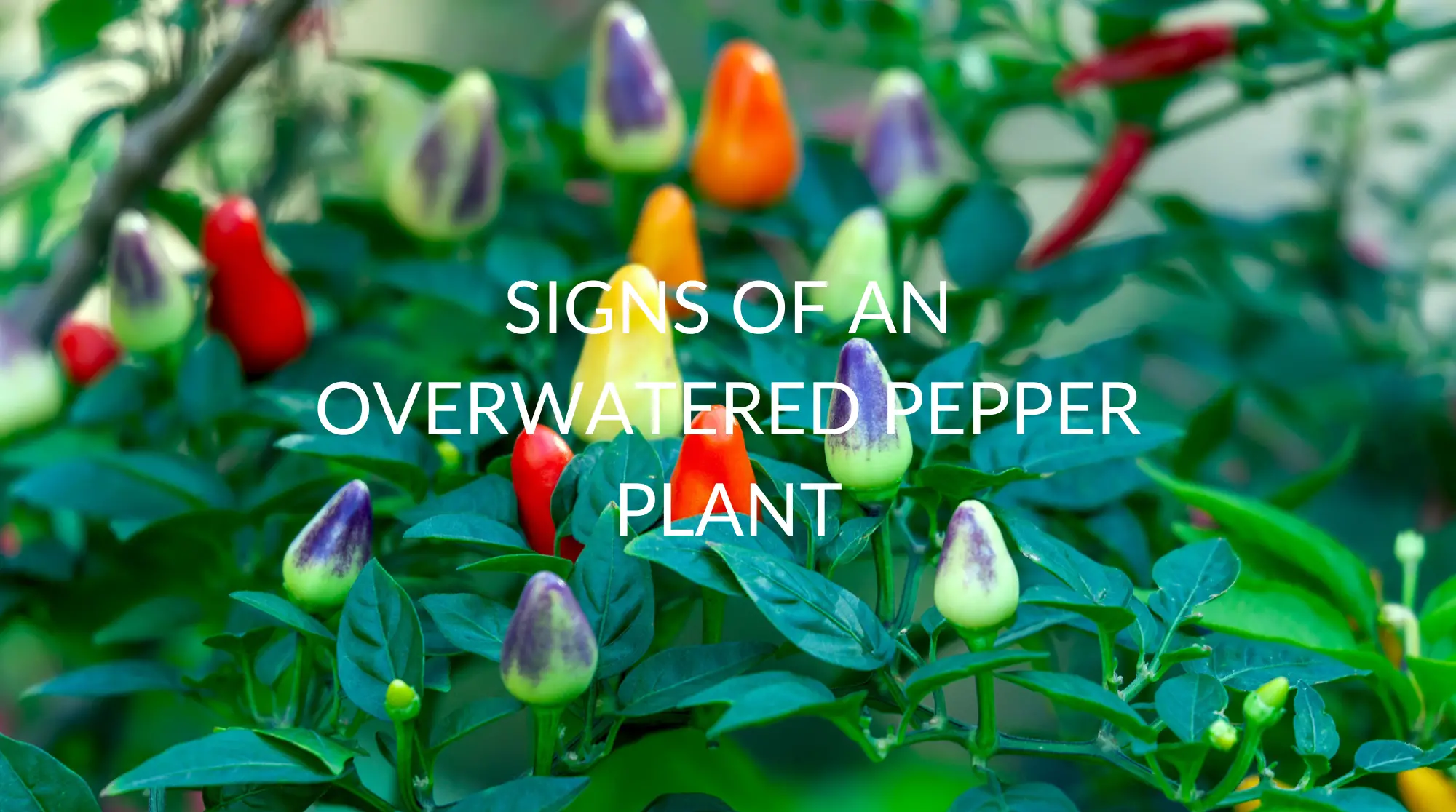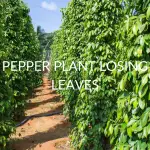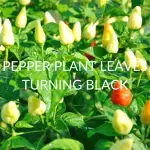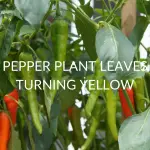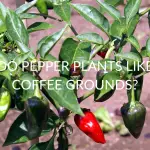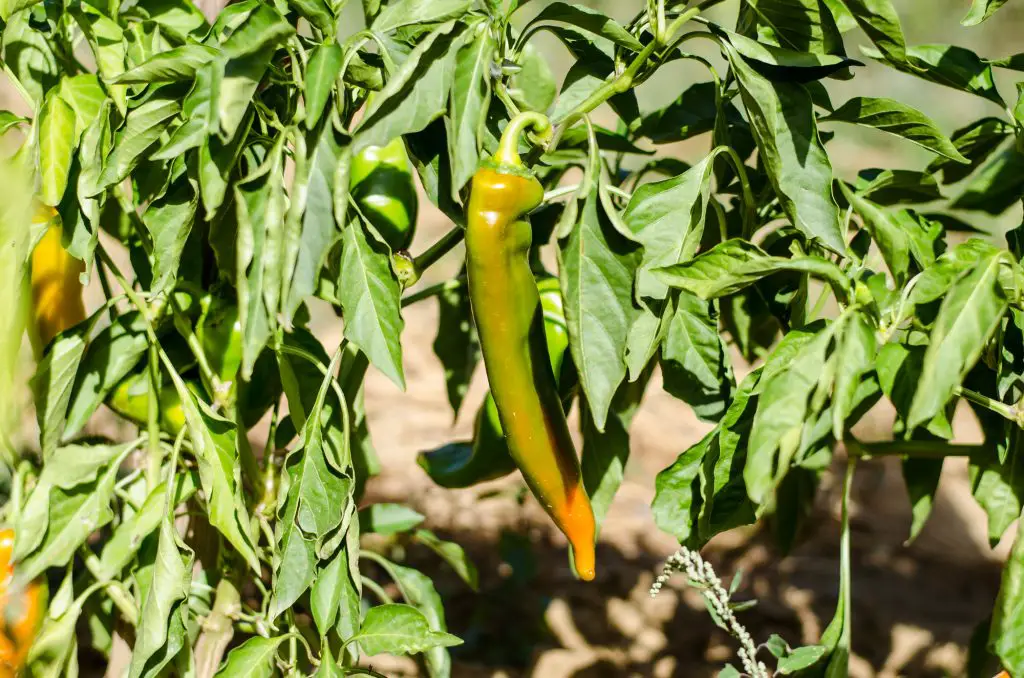Pepper plants are some of the heartier fruit-producing plants you can grow, but that doesn’t make them impervious to overwatering. They can develop yellow leaves, stunted growth, and a lack of peppers if the soil retains too much water. In this article, we’ll explore what overwatered pepper plants look like, how to avoid them, and what to do when the signs occur.
What Do Healthy Pepper Plants Look Like?
We need to know what a healthy pepper plant looks like in order to know what an overwatered pepper plant looks like. You’ll look for an overall healthy green sheen, broad leaves, steady growth patterns, and plenty of peppers.
Rich, Green Color
Pepper plants have a naturally rich green color throughout their leaves and stems. If you notice any yellows or browns, this can mean you’re overwatering or underwatering. The new leaves will be a brighter green than the old leaves.
Broad Leaves
When healthy, the plant’s leaves will not droop or curl. In hot peppers, the leaves will have a slight “v” form. If you’re unsure what we mean, think about a hard-shelled taco. Finally, the leaves should extend outward to reach their maximum amount of sunlight.
Sturdy Stems
Keeping the stems stable is vital because this protects the plant from wind, rain, and animals. The branches of the plant and the leaves should be sturdy (almost rigid) and moderately flexible. There shouldn’t be any leaning or drooping.
Steady Growth
Sweet peppers should mature within 60-90 days, while hot peppers should take around 150 days (if you transplanted the plant). You’ll know the plant is mature when you begin to see flowers or pepper buds. The plants should reach anywhere from 3 feet to 6 feet.
An Abundance of Peppers
Healthy pepper plants will produce a lot of peppers because the plant isn’t stressed for resources. Each variety of plant will produce more or fewer peppers. For example, a good bell pepper crop is 5-10 peppers, while a chile plant could have 30-50 peppers.
Can You Overwater Pepper Plants?
Pepper plants are easy to overwater, especially when growing spicier varieties. Most chiles originate from dry, arid Mexican climates where the soil is sandy and draining. Even sweet peppers do well in drier soils. The roots can become waterlogged and begin to die off because they’re “drowning.”
Overwatering pepper plants in pots is easy because there’s less room for excess water. You won’t have to worry as much when planting peppers into the ground.
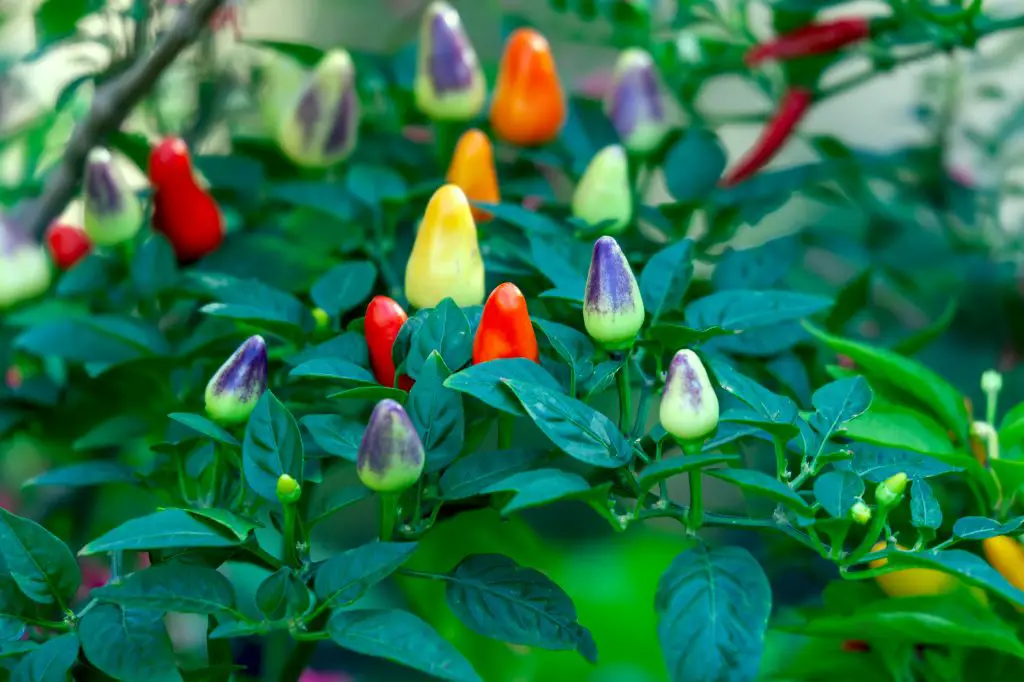
Signs You’re Overwatering Your Pepper Plants
It’s essential to pay attention to what your plant is telling you. If the leaves are wilted or curled, you may need to scale back on the watering.
Wilted Leaves
Too much water will weaken the leaves and cause them to droop downwards. Chile plant leaves may also lose their “v” shape and flatten out.
Yellowing Leaves
This is due to “chlorosis,” or the yellowing of leaves caused by a lack of chlorophyll. When plants are overwatered, they can’t produce chlorophyll as efficiently. This results in the leaves turning yellow and dying off.
Curled Leaves
This correlates to wilted leaves. Once the leaves have wilted, you may notice the leaf curling inwards on itself. This is the final stage of the leaf dying; if possible, you’ll want to remove these leaves so the plant doesn’t try to save them.
Stunted Growth
Like yellowing leaves, a lack of chlorophyll results in stunted or slowed growth. Chlorophyll is what the plant “eats” to stay alive and healthy, and if the plant can’t make enough, it will stay shorter or grow slower to preserve nutrients.
Drooping Stems
You’ll quickly notice drooping stems because the plant will begin leaning to either side. This won’t be the end of your plant if you have it staked, but it still indicates too little or too much watering. The top of the pepper plant will begin to droop first because it’s the furthest from the roots.
Lack of Peppers
A plant produces a lot of peppers when healthy and fewer peppers when ill. If you notice your bell pepper plant is only growing 2 or 3 peppers, you’ll want to check the dampness of the soil. This is especially important if the plant produces a lot of flowers but no fruit.
Dropping Flowers or Peppers
A plant dropping its flowers or peppers is exactly what it sounds like. When the plant is stressed, it will sever the connection between the flower buds or the fruit to preserve resources for the rest of the plant. If you find the pepper pot filled with flowers or unripe peppers, this is what’s occurring.
If you had rough weather the day or night before, it could be Mother Nature tossing your plants around. Look for flowers and fruit dropping after relatively quiet nights. It’s important to note that some pepper plants will shed their flowers after the pollination season. This is normal, and the flowers will appear browned or dying.
How To Fix Overwatered Pepper Plants
If your pepper plant shows any of the above symptoms, it may be time to play doctor. Don’t worry – there are plenty of ways to save a pepper plant if you intervene quickly enough. While plants don’t usually die from overwatering within the first 72 hours, it can affect their growth rates and fruit production.
Stop Watering
A no-brainer, right? If you notice your plant is overwatered, take a few days before you water it again. In those few days, pay close attention to how the plant is doing. If it seems to be improving, then leave it as it is. If it looks like something is still wrong, or the water isn’t leaving fast enough, you’ll have to take additional measures.
Move the Peppers to a Shaded Area
This can be contrary to your first instinct. Don’t we want the sun to remove the extra water? Plants don’t think the same way we do. An overwatered plant is a stressed-out plant, and quick evaporation can promote further stress.
Think about how you would feel if you were pulled from a dunk tank and then blasted with an industrial sun lamp to dry you off. It doesn’t sound super comfortable, does it?
Damp soil will also get very hot in the sunlight and can promote root rot faster than shade does. You’ll want the evaporation process to happen slowly and naturally in a temperature-neutral location. This step is specifically for potted peppers.
Prune Dying Leaves
Plants will continue to feed all leaves until they completely die off, resulting in a waste of nutrients and resources. Pruning the dying leaves will encourage the plant to only expend energy on healthy parts of the plant (and on producing fruit).
Slowly Reintroduce Plants To Direct Sunlight
If you did remove the pepper plants from sunlight, slowly reintroduce the plants to full sun. Start with only a few hours each day in direct sunlight before leaving them there all season. This is similar to hardening seedlings and can help a plant grow stronger after the overwatering.
Repot Peppers Into Better Soil
If you notice the soil is holding too much water, you can replant your peppers into a more appropriate sand/soil mixture. This encourages drainage and mimics the plant’s natural environment. You’ll need to fertilize the plant more often in this case because the soil is naturally less supportive.
How Often Should Pepper Plants Be Watered?
How often you water your pepper plants will change on the weather and the season. The best thing to do is to check the soil and see if the top layer is moist. If it is, the plant doesn’t need water. If it’s dry, you can give it a little spritz.
When the plants begin producing peppers, you may need to water them more frequently. Producing fruits is incredibly taxing to plants and uses more resources than during the rest of the year.
Tip: If you want spicier peppers, water the plant less! The lack of water results in higher capsaicin production and concentrates the peppers’ flavors. This is an excellent technique if you’re growing peppers to consume and not as ornamental plants.
Watering Potted Pepper Plants
On the longest and hottest days of the summer, you may need to water the plant every day if the peppers are in full sun. In the spring and fall, you’ll only need to water the plant once every 2-3 days. If you’re growing them in a greenhouse, you can water them less because of the natural humidity.
Watering Outdoor, In-Ground Pepper Plants
If your pepper plants are in the ground, they’ll need much less water than potted plants. Depending on the weather, you may only need to water them once a week. You can encourage deep root growth by occasionally watering heavily and then not watering at all.
What Do Pepper Plants Look Like When They Need Water?
Unfortunately, plant symptoms look similar no matter what’s wrong with them. You’ll find many of the same signs in this list as you did in the overwatering list. We’ll try to explain what to look for and how these signs appear differently.
Dry Soil
If the soil’s top layer is dry, give the plant a few splashes of water. I put a popsicle stick (I buy them from the Dollar Store) halfway into the soil. When I want to water my plants, I pull the stick out and see if the wood is damp.
If the popsicle stick is damp up to the top of the soil, I don’t water the plant that day. If it’s only wet at the bottom, I water it lightly. If the stick is completely dry, I water it thoroughly. This is an excellent method for determining how much rain your plants may have gotten, so you don’t accidentally overwater them.
Wilting Leaves
Dry wilting leaves feel different than overwatered wilting leaves. Overwatered leaves will feel rubbery and flaccid, while dry, wilted leaves feel dry! They feel more like paper and feel thinner than healthy leaves.
Drooping Stems
Drooping stems are hard to differentiate and need to be considered with other context clues. If the branches are sagging and the leaves are yellowing, it’s a sign of overwatering. If the stems are drooping but the leaves are browning, the plant needs to be watered.
Browing Leaves
Leaves only brown when dying, so this is a sign of underwatering. The edges of the leaf will brown first, and then the color will creep closer to the center. Browning of the stems is an extreme sign of underwatering. Remove any completely brown leaves to encourage the healthy leaves to grow.
FAQ’s
What Is The Best Time Of The Day To Water Pepper Plants?
The best time of day to water pepper plants is in the early morning. This way, the noon-time sun can eliminate any excess water left in the soil. Watering them in the evening can lead to the plant sitting in too much water for numerous hours. Only water the plant if the soil is dry in the morning.
Do Sweet or Hot Peppers Need More Water?
On average, sweet peppers need more water than their spicier cousins. For example, you may need to water bell peppers twice a day if they’re planted outdoors in the summertime because they don’t thrive in intense heat. The sweet peppers can shrivel up and die.
On the other hand, hot peppers continue to grow but produce smaller, spicier, and more flavor-concentrated chiles when watered less, so long as you keep an eye out for underwatering.
Conclusion
Overwatering pepper plants can be incredibly easy to do if you don’t know the signs to look for. Wilting leaves, drooping stems, stunted growth, and a lack of peppers are only a few ways you know your plant has had enough water.
Placing the pot in the shade and holding off on watering for a few days is a great first step to ensuring the plant will recover, as well as pruning dying leaves and repotting the pepper plant into well-draining soil.

